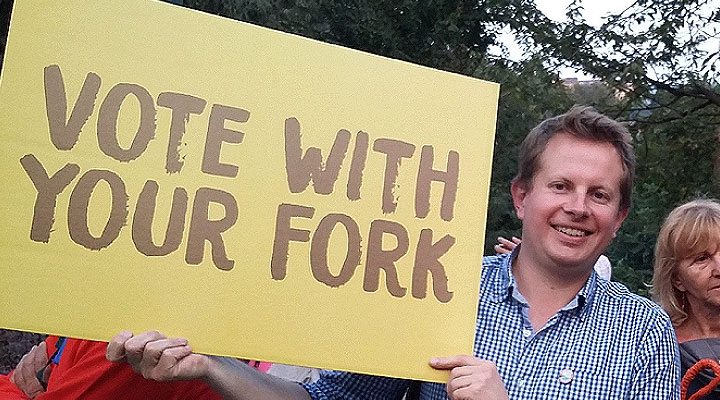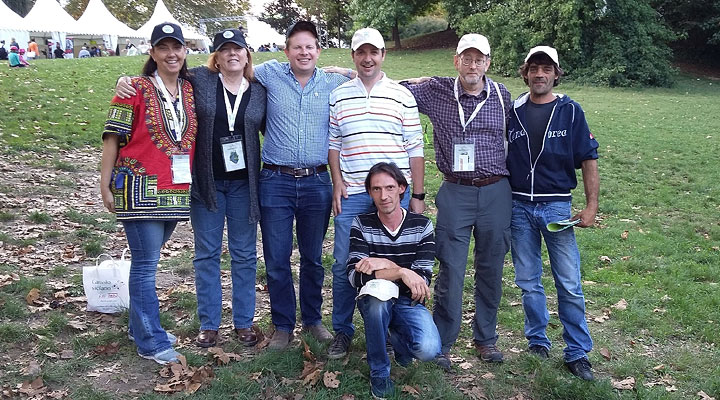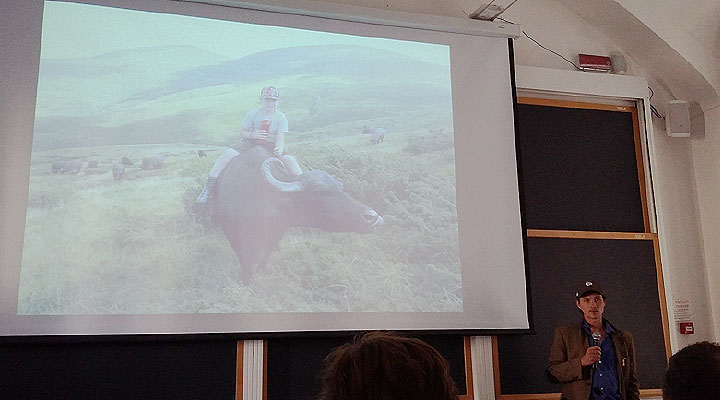Grass-fed organisations come together in Turin
Terra Madre, meaning ‘Mother Earth’, is fast becoming the world’s biggest food event with representation from 140 countries and over 7,000 people taking part in the opening procession alone.
 Russ taking part in the opening procession.
Russ taking part in the opening procession.
It is a celebration of diversity in food and food culture. A place for chefs, farmers and producers to rub shoulders, network, exchange ideas and come together to discuss key issues relating to food and food production.
It presented an excellent opportunity to gather organisations that are also developing grass-fed certification marks and brands in their own countries, to share stories and support one another.
There was representation from the American Grassfed Association, Grassfed South Africa and with the help of a translator three farmers from the newly formed Italian grass-fed organisation AIAG. A Swiss farmer knowledgeable about the situation in Switzerland also joined the meeting, as well as representatives of Slow Food.
 From left to right: Caroline McCann (Grass-fed South Africa), Marilyn Noble (American Grassfed Association), Russ Carrington (Pasture-Fed Livestock Association), Hans Quarteroni (Grass-fed Italia), Joel Smith (Slow Food USA), Fabiano Cantoni (Grass-fed Italia) and front: Patrick Recetti (Grass-fed Italia).
From left to right: Caroline McCann (Grass-fed South Africa), Marilyn Noble (American Grassfed Association), Russ Carrington (Pasture-Fed Livestock Association), Hans Quarteroni (Grass-fed Italia), Joel Smith (Slow Food USA), Fabiano Cantoni (Grass-fed Italia) and front: Patrick Recetti (Grass-fed Italia).
“The meeting was absolutely exhilarating,” said Russ. “It was fascinating that there were so many common themes in each of our, until now independent, development. It was also useful to learn how some of the organisations had overcome various challenges and to see just what is possible.”
Common themes were:
- That ‘grass-fed’ means 100% grass-fed and no grains or concentrate feed are used. All the respective standards in each country have been developed on this basis.
- It takes time to build recognition and credibility with industry organisations.
- It is challenging to represent the genuine value of produce reared entirely on pasture to consumers amongst all the other products in the market, including other unverified grass-fed products, but it is possible.
- There is a lot of work and no quick methods for setting up and managing these kinds of farmer- led movements.
All of the organisations are currently at different stages of development, and operating on quite different scales. The American Grassfed Association is currently certifying farms with herd sizes anything between 5 and 10,000 head, and in South Africa they are developing slaughter hubs where they have a pool with a minimum of 800 cattle to pull from. In Italy they are just three farms in the northern region. Interestingly in Switzerland farmers are incentivised to feed pasture to their livestock via government support payments.
Conversations continued for many hours and the group has already agreed to meet again.
“For the time being the formation of an informal grass-fed alliance is being considered, so that we can continue sharing ideas and supporting one another, which for me has already been very valuable,” concluded Russ.
Pastoralist Workshops
As part of events in Turin there were many other interesting and relevant meetings and seminars taking place. One in particular was a workshop bringing together pastoralists from unique grazing situations from across the globe, including camel herders from Ethiopia, shepherds managing milking sheep in the Pyrenees and Lebanon, and a community of graziers managing a rare herd of water buffalo in the Carpathian Mountains of the Ukraine.
 Michel Jacobi talking about the grazing ecosystem which exists in the Carpathian Mountains in the Ukraine.
Michel Jacobi talking about the grazing ecosystem which exists in the Carpathian Mountains in the Ukraine.
“This particular workshop focused not only on the environmental importance of the work of pastoralists, but also the social benefits that they bring to rural communities.
“There was a sense of growing need for more recognition for the role of pastoralists and the vital grassland systems they maintain through better support for their livelihoods, either via market incentives or forms of environmental payment from governments – the latter not being available at all in some countries.
“The role of grass-fed certification marks to provide the market tool for greater recognition was discussed at length. Although most agreed it was not easy, they were encouraged to learn that various initiatives are beginning to be established.
“It was evident that the people in the room were extremely genuine and modest people with a can-do attitude – traits that I can also identify within the membership of the Pasture-Fed Livestock Association,” observed Russ.
Other initiatives of interest are Slow Food’s ‘Slow Meat’ campaign, a project, which highlights to consumers the different ways of producing meat, and the environmental costs of producing meat in rapid and intensive ways. More information can be found at www.slowfood.com/what-we-do/themes/slow-meat/
The UNFAO (Food and Agriculture Organisation of the United Nations) was also involved in the events and they are in the process of establishing a Pastoralist Knowledge Hub to bring pastoral voices to the global stage. More info at www.fao.org/pastoralist-knowledge-hub



